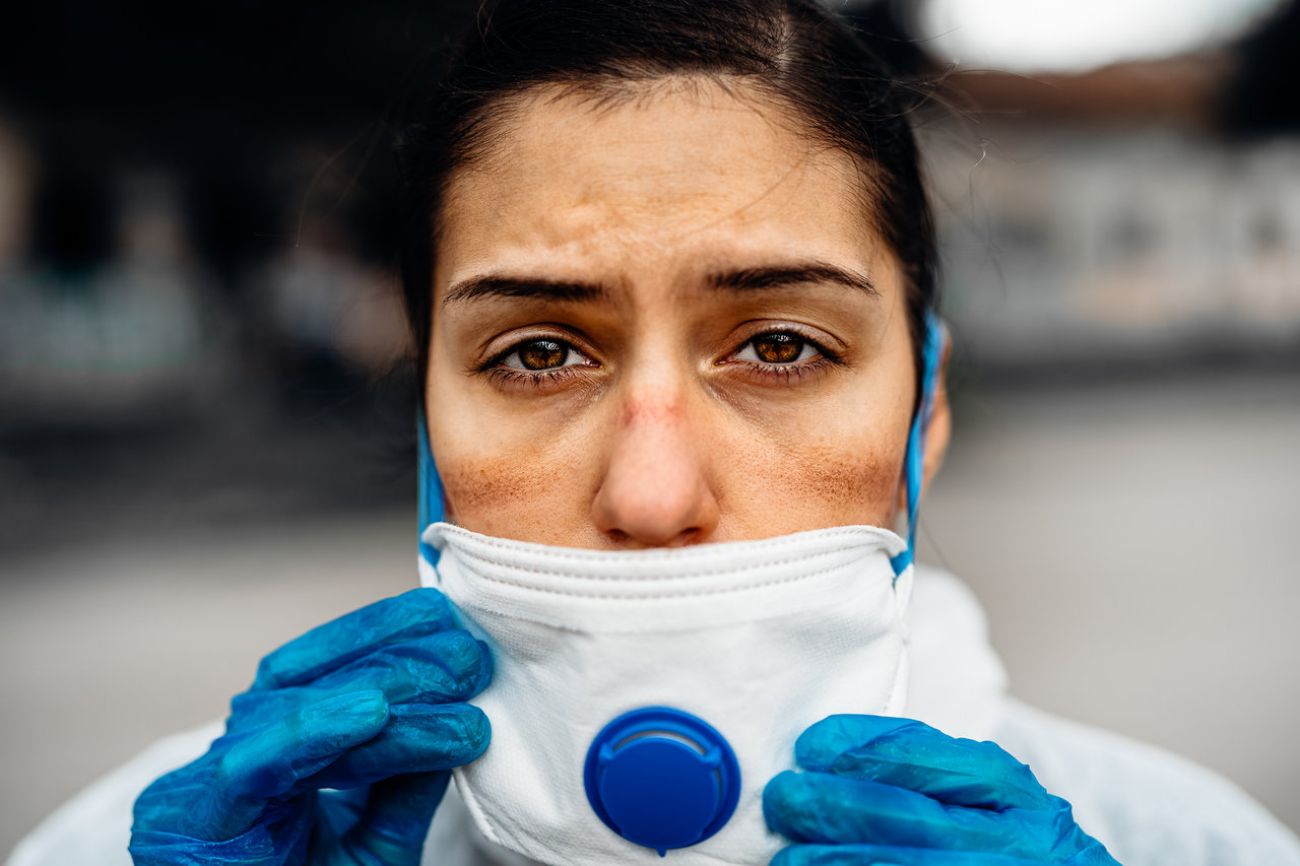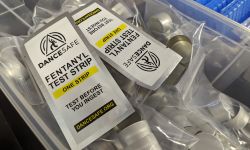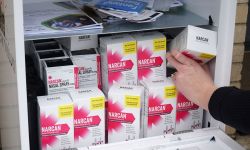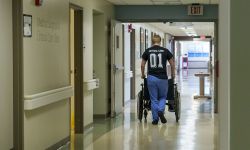Inspections show death, despair gripped Michigan nursing homes amid pandemic

- June 15, 2020: More than 1,900 coronavirus deaths in Michigan nursing homes
LANSING — Nursing homes account for at least 1 in 4 coronavirus deaths in Michigan, and state inspection reports indicate many were ill-prepared for the pandemic, as staff called in sick, used raincoats as protective gear and failed to isolate infected patients.
The reports, reviewed by Bridge, paint a bleak picture as the virus spread through the state’s hardest-hit facilities this spring. At least 27 of Michigan’s 400 nursing homes had 60 or more residents with COVID-19, while 83 had 30 or more.
“We lost six residents in two days and we just had a man die Sunday,” a nursing assistant at Imperial Healthcare Center in Dearborn Heights told state inspectors in late April.
- The latest: Michigan coronavirus map, curve, chart, updated COVID-19 news
- Dashboard: Michigan coronavirus testing numbers, trends, COVID-19 data
- June 1: Whitmer lifts stay-at-home order, will allow bars and restaurants to open
- What Whitmer’s new coronavirus order means for Michigan summer plan
She added that residents with suspected COVID-19 were not properly isolated when they first displayed symptoms, so “it spreads to everybody else.”
In Macomb County’s Advantage Living Center in March, severe staffing shortages in late March meant two nursing assistants were working the night shift in a COVID-19 isolation unit housing 23 seniors.
“I can’t even take a break” because “these patients are critical,” a nurse told inspectors.
''I have one who is actively dying right now.”
Nursing homes nationwide have been devastated by the coronavirus, accounting for one-third of all deaths, according to the New York Times. In Michigan, officials are still getting a handle on the tally because nearly three dozen of the state’s nursing homes have not yet submitted data the state began requiring in late May.
But available records show at least 5,705 Michigan nursing home residents have contracted the virus this year and 1,400 have died as of May 31. And debate is raging about whether Gov. Gretchen Whitmer’s since-revised policy of requiring some homes to accept COVID-19 patients increased the toll.
Bridge reviewed inspection records of nursing homes hit hardest by the pandemic, those with at least 60 cases. Reports on only 13 of 27 of those homes are available, but of those, three were in full or substantial compliance with federal guidance and state rules, despite having advanced warning of the inspections.
The inspections focused on infection control. In some cases, homes were cited for relatively small infractions that health experts say could have large implications in a pandemic, such as staff not wearing gloves at all times or wearing safety gowns wrong.
But some reports point to severe shortages of staff, personal protection equipment and failure to properly isolate sick residents, shedding light on problems inspectors said may have allowed the virus to spread.
“There are a handful of facilities — maybe more than a handful in our state — that were not well prepared and didn't take the right steps to react to the outbreak when it did occur,” said Salli Pung, the state’s independent long-term care ombudsman who advocates for Michiganders in nursing homes.
“I think that put residents at even more risk.”
- Related: Michigan nursing homes linked to 1 in 4 coronavirus deaths. Tally will grow.
- Related: Michigan continues to stumble in tracking coronavirus in nursing homes
- Related: Coronavirus, an 'almost perfect killing machine,' hits Michigan nursing homes
Still, she said the pandemic hit Michigan so quickly that “early on, I don’t know if they could have been prepared to handle the impact of COVID-19 even with the best infection prevention controls in place. At some points, it really was overwhelming.”
Whitmer’s administration has been slow to collect and disclose data about individual nursing homes, which advocates say has prevented family members and the general public from fully understanding the plight of older residents particularly vulnerable to the infectious and deadly disease.
The state on May 29 began publishing cumulative case counts within each nursing home but has not yet published death counts from the facilities, data that health officials say they are still working to validate.
“The more we know about what they’re doing, the better we can understand best practices — who’s doing what right, and who’s not,” said Mark Hornbeck of AARP Michigan. “To help us safeguard the residents, it’s important to have information.”
Available data show that more than half of Michigan homes were spared from the virus, but outbreaks were common in the 193 facilities the virus did reach. Those homes reported an average of 30 resident cases each.
State data suggests the virus hit some of the state’s best and worst nursing homes without discrimination, according to a five-star rating system created by the Centers for Medicare & Medicaid Services, a federal agency that oversees certified nursing homes across the country. Michigan nursing homes that have had at least 60 COVID-19 cases include one-star and five-star facilities, collectively averaging roughly three stars.
‘It feels horrible’
Clad in full-body protective gear, state inspectors descended on the Advantage Living Center in Roseville on March 28, as the coronavirus sickened staff and residents, at least 60 of whom have contracted the virus this year.
Inspectors found a staff spread thin: Six nursing assistants had failed to show up for an overnight shift, leaving one assistant to care for 23 residents in a COVID-19 isolation unit and two others to care for 72 other residents, according to an inspection report.
The following day, two of seven nursing assistants scheduled for the overnight shift showed up, again leaving one to care for 23 residents in isolation and one to care for the other 72 residents. There was generally one certified nurse for each unit as well.
Staffers were still completing overnight rounds and room cleaning in the first morning when inspectors arrived. Some residents were in bed wearing only underwear, and one told them “they were not receiving their baths or showers,” an inspector wrote.
“It feels horrible,” one nursing assistant told them, noting she was only able to visit 23 of 41 residents in a non-isolation unit that night.
By then, nine of the home’s residents had died, and Advantage increased “likelihood of infection and/or death for all 95 residents” by failing to provide proper care to 23 residents in its COVID-19 unit and allowing “cross contamination,” inspectors wrote.
The inspector concluded residents had been in “immediate jeopardy” since March 12.
Inspectors wrote they saw nurses coming and going from the COVID-19 unit without changing personal protection equipment, which was in short supply across the state and nation in late March.
Advantage Living Center, which has a two-star rating from the federal government and is not a designated regional hub, had been unable to obtain tests for the virus.
But “pretty much everyone” in the isolation unit had a fever, a nurse told inspectors. “'They told me these people [residents] are all pneumonia but it is not like I have time to look up medical information.'''
The nursing assistant who also worked the isolation unit that night said 98 percent of residents required assistance or were incontinent.
Asked about their ability to visit resident rooms regularly throughout the night, the assistant said simply: “I can’t.”
The nursing assistant was wearing a hospital patient gown and told inspectors staff had not been provided eye protection. A housekeeper assigned to the unit told inspectors she was directed to wear the same mask for 30 days and kept it in a Ziploc bag when leaving for home.
Advantage Living Center did not respond to inquiries from Bridge. In a plan of correction submitted to the government in April, management reported that staffing levels had “improved” since the inspection and said the home had “aggressively” hired workers to address “shortfalls related to the outbreak of employee illnesses.”
“During these unprecedented times, the facility management has contacted temporary agencies and increased back up staffing to address staff call ins,” Advantage said.
In its written response to the recent COVID-19 inspection, Advantage noted that a Whitmer worker safety order allowed employees to stay home if they displayed “one or more symptoms” of the virus.
The facility is “working extensively with team members to address concerns about the virus and overcome personal team member challenges to assist them in coming to work,” management wrote.
Advantage did not initially require staff to wear face masks to conserve limited supplies but said it has done so since March 19 “despite shortages.”
“The facility continues to request gowns and thermometers from state and local agencies, but they are not available and are in short supply,” Advantage officials said. “Given the national shortage of PPE, the facility has improvised using patient gowns when no gowns are available from state and local authorities and vendors.”
State policies scrutinized
Lynn Sutfin, a spokesperson for the Michigan Department of Health and Human Services, said the state has taken the personal protection needs of nursing homes “very seriously” since “day one” of the pandemic.
“Unfortunately, at the peak of the crisis, the state was severely limited in our PPE supply and most of what was available was directed to hospitals at the forefront of the fight against COVID-19,” she told Bridge, referencing shortages Whitmer has blamed on the federal government.
The state has also utilized the National Guard to expand voluntary coronavirus testing for nursing home staff and residents across the state, Sutfin said. As of late May, the National Guard had either completed testing or was doing so in 47 of Michigan’s 83 counties.
Whitmer first closed nursing homes to visitors on March 14, noting the “risk of severe illness and death from COVID-19 is higher in older adults and those with chronic health conditions.”
A month later she issued new nursing home regulations she predicted would “protect the most people we can in those facilities,” a claim some have subsequently questioned.
The governor’s April 15 order required nursing homes at less than 80 percent capacity to create dedicated units for “COVID-19 affected residents” and mandated they take in new patients with the coronavirus so long as they had appropriate personal protection equipment for employees.
The order also allowed the health department to designate certain nursing homes as “regional hubs” to accept COVID-19 patients that other facilities could not.
To date, the state has created 20 hubs. As of Wednesday, inspectors had published infection control surveys for 10 of the 20 Michigan homes currently designated as regional hubs. Of those, three were in full or substantial compliance while seven others were cited for minor infractions such as not taking patient temperatures frequently enough.
Critics contend Whitmer’s initial readmission policy for nursing homes put non-infected residents in harm’s way. State Rep. Leslie Love, a Detroit Democrat who has otherwise complemented Whitmer’s response to the pandemic, called the approach an “epic fail.”
Inspection reports reviewed by Bridge shed little light on that debate because they do not consistently indicate whether homes were accepting hospital discharged patients. In at least one case, a home that did was cited for not following isolation rules.
Regulators last month cited Fairlane Senior Care and Rehab Center in Detroit for failing to quarantine two residents who were readmitted from the hospital with “unknown COVID-19 status.”
Fairlane, which the state says has had 101 confirmed cases, placed those readmitted patients into rooms with residents who did not have COVID-19, inspectors said.
Whitmer revised her emergency rules on May 20 to recommend — rather than require — nursing homes to create dedicated units. And if they don’t have an isolation unit, the state now says nursing homes should not accept COVID-19 patients discharged from the hospital.
In a congressional hearing Tuesday, Republican lawmakers grilled Whitmer over the state’s response to COVID-19 nursing home outbreaks.
“Why did it take so long to change the policy, not only of putting COVID patients back in the nursing homes, but also reporting?” U.S. Rep. Tim Walberg, R-Tipton, asked Whitmer.
Whitmer said the initial policy was informed by “public health experts across the country and at the University of Michigan.”
“We recognize that, of course in retrospect, probably a number of decisions we would have made some adjustment in,” she said.
At least three other states hit hard by the virus, California, New Jersey and New York, also had adopted similar policies to reduce crowding within hospitals, according to the New York Times.
Separately, the federal Centers for Medicare & Medicaid Services released a series of infection control recommendations to nursing homes on April 2, saying they had “become an accelerator for the virus because residents, who are generally vulnerable to complications from the virus, are even more so in an enclosed environment.”
State Sen. Pete Lucido, R-Shelby Township, last week introduced legislation that would prohibit nursing homes from accepting COVID-19 hospital discharges unless the patients had “since recovered from the coronavirus.”
Lucido’s legislation would require the state to open eight regional “centralized intake facilities” to house COVID-19 patients no longer eligible for hospital stays.
That would be an “ideal” approach if there is a second wave but would be difficult for the state to quickly establish and staff, said Pung, the nursing home ombudsman.
“Staffing is more critical than it ever has been, and I think it would be a big barrier to creating those COVID-only sites.”
Whitmer’s initial order may have been “misinterpreted early on” and did not require nursing homes to accept hospital discharges if they were not prepared to do so, Pung said.
Raincoats instead of scrubs
Imperial Healthcare Centre in Dearborn Heights, a two-star facility that is not one of the state’s regional hubs, had been accepting hospital discharges when inspectors arrived April 24 and concluded that staffers had failed to properly isolate its residents.
Staff also did not always use appropriate personal protection equipment, inspectors found.
At the time, facility staffers told inspectors that 70 of their 184 residents had COVID-19 symptoms and 29 had died. The assistant director of the facility and four staffers also tested positive for COVID-19.
“At one point we only took [COVID-19] positive admits but then we started having temps show up on C and D [Units,],” the director of nursing told inspectors.
“We aren’t taking any [admits] for a couple days now.''
Imperial was attempting to house all COVID residents in Unit B, which had previously been utilized for residents with dementia, along with Unit C, and had closed those units off from other areas of the nursing home using a fire door and zippered tarp.
''We went a while where there was a whole bunch of bad shit happening on B Unit,” the director of nursing said. “All of B [unit] was struggling. We ran IV’'s [intravenous therapy- fluid replacement through a vein] on a lot of [residents.]''
One of the first residents diagnosed with COVID-19 was also “the biggest wanderer in the facility,” the director of nursing said. That resident’s roommate caught the virus too, and died, according to the report.
Imperial’s nursing home administrator acknowledged they had recently accepted discharged hospital patients into Unit D, describing that non-isolation area as an “in-between unit as of a couple of days ago,” and some of those residents subsequently tested positive.
A nursing assistant told inspectors that Imperial had only started isolating symptomatic residents “two weeks ago” and appeared troubled by that fact. While management would “try” to consistently assign staff to specific units to avoid cross-contamination, that wasn’t always possible, the director of nursing said.
Imperial staff generally had access to personal protection equipment, but not gowns, according to the report.
They wore raincoats instead, and inspectors occasionally observed staff wearing those coats with the fronts open, limiting their effectiveness.
One nursing assistant told inspectors she didn’t close the raincoat because it “doesn’t fit.” A certified nursing aide said she didn’t wear one because it made her sweat too much.
That same aide was also observed wearing a mask under her chin and no gloves while delivering lunch to a resident in a COVID unit.
Imperial officials, in an official response to the inspection, told regulators they’ve dedicated a clinical nurse to focus on infection control and said staff were being “re-educated” on proper protocols and use of personal protection equipment.
The home also promised periodic audits to ensure continued compliance with COVID rules.
An Imperial administrator declined to comment on the inspection report, but in a lengthy statement provided to Bridge, the home’s parent company, Villa Healthcare of Chicago, outlined additional safety precautions and praised “heroic staff” on the frontlines of the pandemic.
To date, Imperial has accepted 51 COVID-positive patients and has “graduated 54 residents off COVID-positive status and returned (them) back to health,” Villa said. Imperial now has just four COVID-poisitive residents in its 265-bed facility.
“When most of this country has been asked to stay home, Imperial, a Villa Center staff has stepped up and continues to provide quality care and support to their residents,” the company said.
“Their contribution on the front lines of healthcare are no less valuable and are just as laudable as the efforts of the doctors, nurses and aids in the hospital setting. Today, our heroes don’t wear capes. They wear scrubs and face masks, and whether they serve in the hospital or in the nursing home, they are all heroes.”
See what new members are saying about why they donated to Bridge Michigan:
- “In order for this information to be accurate and unbiased it must be underwritten by its readers, not by special interests.” - Larry S.
- “Not many other media sources report on the topics Bridge does.” - Susan B.
- “Your journalism is outstanding and rare these days.” - Mark S.
If you want to ensure the future of nonpartisan, nonprofit Michigan journalism, please become a member today. You, too, will be asked why you donated and maybe we'll feature your quote next time!








